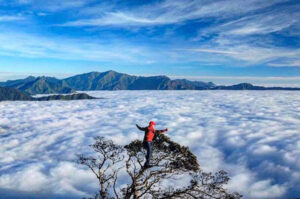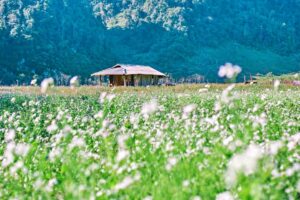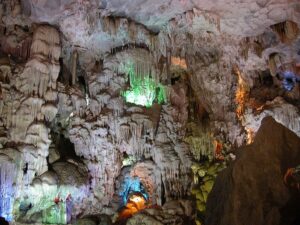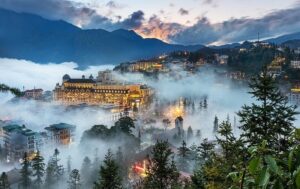Yen Bai
Yen Bai, the gateway to Vietnam’s Northwest, is home to over 30 ethnic groups living harmoniously together. This region is the cradle of ancient Vietnamese culture, with the Red River and Chay River civilizations, and serves as a cultural crossroads between the northeastern and northwestern parts of the country. With a wealth of revolutionary historical sites, scenic landscapes, and a system of temples, pagodas, and shrines associated with the nation’s founding and defense, Yen Bai is an attractive destination for tourists.

Yen Bai is known for its pristine beauty that captivates the heart, with a cool climate and natural landscapes that resemble a stunning painting. The region is home to famous destinations such as the terraced rice fields of Mu Cang Chai, the Suoi Giang tourist area, and Thac Ba Lake. Visitors can not only admire the beautiful landscapes that nature has generously gifted but also immerse themselves in the unique cultural festivals and traditions of this area.
Mu Cang Chai Terraced Rice Fields

The first destination that comes to mind for travelers visiting Yen Bai is the Mu Cang Chai terraced rice fields. Even a single visit to Mu Cang Chai allows visitors to experience the abundance of nature, the richness of culture, and the warmth of its people. Crossing Khau Pha Pass, with the mountain peaks covered in a sea of clouds and a cool climate year-round, visitors will be treated to the stunning view of the Mu Cang Chai National Scenic Area. The terraced rice fields, covering an area of 2,500 hectares across the communes of Che Cu Nha, La Pan Tan, and De Su Phinh, were recognized as a National Scenic Site by the Ministry of Culture, Sports, and Tourism in 2007. The terraced fields here are like fingerprints of the sky, a masterpiece of architecture creatively shaped by the skilled hands of the H’mong people.
In spring, visitors will see the fields adorned in the fresh green of new rice shoots and the colorful blossoms of peach and plum flowers. However, the ideal time to visit and admire the terraced fields is during the rice harvest season in September and October. At this time, visitors will be awed by the sight of the “golden trays” of rice, with terraces stretching down the hills in endless rows.
Muong Lo – The Rice Basket and Traditional Xoe Dances

From Yen Bai City, about 80 kilometers west along National Route 32, visitors will reach the Muong Lo Valley in Nghia Lo Town. Nestled in the Nghia Lo and Van Chan districts, Muong Lo is a flat valley with expansive rice fields. Among the four large, famous valleys in the Northwest known for their beautiful landscapes and fresh air, Muong Lo ranks second after Muong Thanh (in Dien Bien Province). From above, the valley looks like a giant pan, surrounded by mountain slopes shrouded in clouds year-round.
In Muong Lo, visitors can not only enjoy the golden rice fields and the charming late autumn sunshine but also immerse themselves in nature’s tranquility. Visitors can experience the rich flavors of local specialties such as delicious white rice, the famous Tu Le sticky rice, five-colored sticky rice, black banh chung, dried buffalo meat, smoked pork, dyed rice, and fish sticky rice. One of the most unique experiences here is tasting dishes made from insects and moss. Visitors will also be enchanted by the sound of the “khen” (a traditional flute), the graceful Xoe dances of the Thai people, the joyful songs of the Thai people, and the lively atmosphere of spring festivals, the Chom Chieng dance, and the strong taste of “ruou can” (fermented rice wine) while feeling the warmth of the local people.
Suoi Giang, Van Chan

Suoi Giang, located in Van Chan District at an altitude of over 1,371 meters above sea level, enjoys a cool climate year-round. Visitors to this area will not only be immersed in the primeval forests with their fascinating landscapes but also have the opportunity to pick tea, roast tea leaves, and enjoy tea with the friendly H’mong women. Additionally, visitors can participate in the mystical and sacred “Cap sac” ceremony of the Dao people, experience the bustling atmosphere of the spring festivals, or warm themselves in the New Rice Festival of the Thai people.
In Suoi Giang, visitors will be amazed by the centuries-old tea forests, where the Shan Tuyet tea trees stand tall and proud, weathering the storms, sun, and rain. The famous aroma of Suoi Giang Shan Tuyet tea, made by the diligent hands of the H’mong women, is renowned both locally and internationally. Visitors can enjoy a warm cup of this tea and experience the true flavor of this unique tea.
Thac Ba Lake Exploration
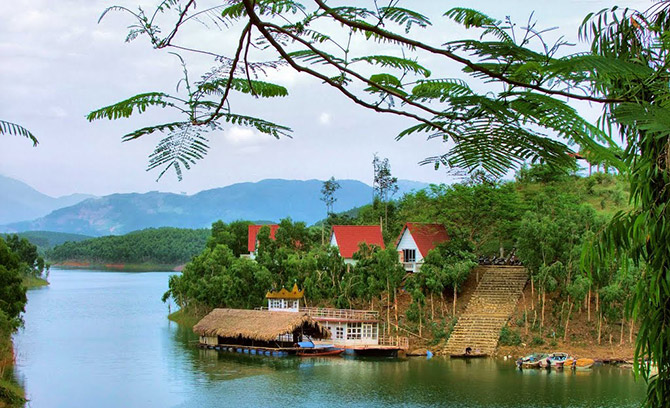
In 1996, Thac Ba Lake was recognized as a National Historical and Scenic Site. Thac Ba Lake is one of the three largest artificial lakes in Vietnam and is known as an attractive ecological tourism destination. Here, visitors can immerse themselves in the ethereal beauty of Thac Ba Lake, covering nearly 20,000 hectares and consisting of 1,331 islands of various sizes. Cruising through the islands, visitors can enjoy the cool, fresh air, admire the vast green forests, and see the picturesque islands that create a magical and charming landscape. The journey also includes visits to beautiful caves such as Xuan Long Cave, Thac Ba Cave, and Ong Waterfall. Particularly, Thac Ba Cave is associated with the mysterious legends of the love story between Prince Trong Hai and Princess Thuy Tien, as well as the historical sites around the lake, such as the Thac Ba Temple, Sao Pagoda, and the Cao Bien Linh Son mountain range.
Not only is Thac Ba Lake known for its scenic beauty, but it is also home to 12 ethnic groups with diverse cultures, and unique traditional festivals are held during the early spring, such as the Long Tong festival of the Tay people and the Dao people’s harvest festival. Visitors can enjoy traditional dishes such as lam rice, forest banana flower salad, chicken cooked with lime leaves, roasted pigs, and fish or shrimp salad while appreciating the hospitality of the local ethnic communities.
